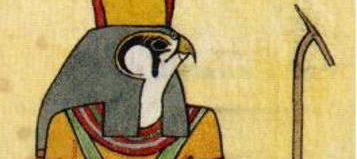This remarkable lunar invocation (PGM VII.756-794) often passes unnoticed in The Greek Magical Papyri in Translation because its structure, based on the 28 forms of the moon, is obscured by both the translation and the layout of the text. In my original translation below, I have emphasized the increasing intensity of the sounds – called the “companions” of the moon’s name – which correspond to the fourteen days of the waxing moon. (Presumably, the order of the sounds would be reversed for the waning moon.) I have also numbered the 28 forms that follow and arranged them in groups of seven to aid understanding of the correspondences, but the numbering itself was not present in the manuscript (and thus is not part of the performed rite).
The lunar invocation is useful for many purposes: as a standalone rite, as a daily (or nightly) devotion to attune oneself with the progress of the moon’s power throughout the lunar month, or paired with other rituals to enhance their effect. During the waxing or full moon, rituals intended to produce a positive effect can be augmented, while the waning moon can be leveraged to produce lessening effects, ancient examples of which include the reduction of fever, the expulsion of daemons, or even the calming of a storm while at sea.
In the Hermetic and Neoplatonic worldview of cosmic sympathy, the moon is associated with the activity or energy (ἐνέργεια) of increase (αὐξητική) and decrease (μειωτική), as well as the divine gifts of silence (σιγή), sleep (ὕπνος), and memory (μνήμη). The lunar sphere also offers control over fear (φόβος) and daemons (δαίμονες). Many goddesses are associated with the sphere of the moon, including Hekate (Ἑκάτη), Artemis (Ἄρτεμις), and Isis (Ἶσις). As the sphere associated with the threshold between the circular (divine) motions of the heavens and the rectilinear (mortal) motions of the material world, the moon presides over ever-changing nature (φύσις) as the domain of Isis. Physis, the Greek word often translated as “nature,” is etymologically related to the verb φύειν (to grow) and the noun φυτά (plants).
PGM VII.756-794:
Prayer:
“I invoke you who have all forms and many names, double-horned goddess, Mēnē, whose form no one knows except him who made the entire cosmos, IAŌ, the one who shaped you into the twenty-eight figures (σχήματα) of the cosmos so that you might complete every form (ἰδέα) and distribute breath (πνεῦμα) to every animal and plant, that it might flourish, you who wax from obscurity into light and wane from light into darkness.
“And the first companion of your name is silence (σιγή),
the second is a popping sound (ποππυσμός),
the third a sighing (στεναγμός),
the fourth a hissing (συριγμός),
the fifth a cry of joy (ὀλολυγμός),
the sixth a moaning (μυγμός),
the seventh a barking (ὑλαγμός),
the eighth a bellowing (μυκηθμός),
the ninth a neighing/thundering (χρεμετισμός),
the tenth a voice harmonious (φθόγγος ἐναρμόνιος),
the eleventh a breath endowed with speech (πνεῦμα φωνᾶεν),
the twelfth a wind-creating wail (ἦχος [ἀ]νεμοποιός),
the thirteenth a coercive voice (φθόγγος ἀναγκαστικός),
the fourteenth an irresistible effluence of perfection (τελειότητος ἀναγκαστικὴ ἀπόρροια).
1. ox (Βοῦς)
2. vulture (γύψ)
3. bull (ταῦρος)
4. scarab beetle (κάνθαρος)
5. falcon (ἱέραξ)
6. crab (καρκίνος)
7. dog (κύων)
8. wolf (λύκος)
9. serpent (δράκων)
10. horse (ἵππος)
11. chimera (χίμαιρα)
12. asp (θέρμουθις)
13. she-goat (αἴξ)
14. he-goat (τράγος)
15. baboon (κυνοκέφαλος)
16. cat (αἴλουρος)
17. lion (λέων)
18. leopard (πάρδαλις)
19. field mouse (μυγαλός)
20. deer (ἔλαφος)
21. multiformed one (πολύμορφος)
22. virgin (παρθένος)
23. torch (λαμπάς)
24. lightning (ἀστραπή)
25. crown (στέλμα)
26. herald’s wand (κηρύκειον)
27. child (παῖς)
28. key (κλείς)
“I have spoken your signs (σημεῖα) and the symbols (σύμβολα) of your name, in order that you might hear me, because I pray to you, the mistress of the entire cosmos. Listen to me, steadfast one, mighty one: APHEIBOĒŌ MINTĒR OKHAŌ PIZEPHUDŌR KHANTHAR KHADĒROZO MOKHTHION EOTNEU PHĒRZON AINDĒS LAKHABOŌ PITTŌ RIPHTHAMER ZMOMOKHŌLEIE TIĒDRANTEIA OISOZOKHABĒDŌPHRA.” (add the usual)
***
NOTE: Some have suggested the 28 forms are relatable to the lunar mansions. Although I have no doubt the rite can be adapted for this use, the 28 forms in their original Greco-Egyptian context would have been the visible days of the waxing and waning moon, excluding the “invisible” new moon. This would allow the performer to adjust for the discrepancy between the 28-day idealized month (of four planetary weeks) and the roughly 29.5-day synodic month (the moon’s waxing and waning cycle). The lunar mansions, on the other hand, express the moon’s relationship to the “fixed” stars of the sidereal ecliptic, and not to the waxing and waning cycle of the synodic month. In other words, because the mansions do not sync with the phases, relating the 28 forms to the lunar mansions obscures the obvious connection between the increasing intensity of the sounds and the growing light of the moon over the 14 days of the waxing cycle.
Translation and commentary © Copyright 2020 PracticalTheurgy.com. Do not copy or distribute without written permission.
